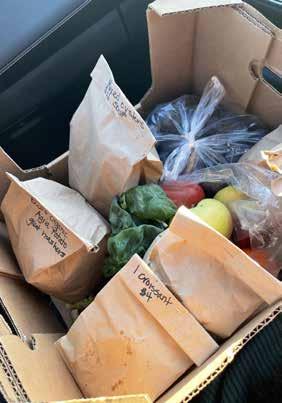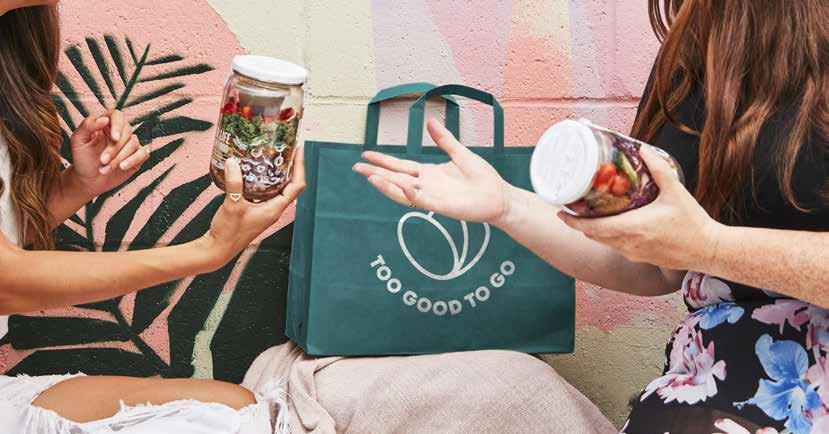
7 minute read
Got an Appetite for Savings?
Rising food prices or not, Canadians still love eating out. Calgary resident Janice Chao is no exception. “I love exploring our local culinary scene and trying new things,” says the Calgarian foodie also known as @hungrygirlyyc. For someone who enjoys anything from crunchy pakoras to durian pizza, Chao’s adventurous palate comes with a price tag.
Rising Food Costs
With inflation and an ongoing tariff war, stretching food dollars is especially important – whether you’re a foodie or just trying to feed your family.
Canada’s Food Price Report predicted an additional $800 of food spending per year for a family of four in 2025. Overall, it forecasts Canadians spending three to five percent more on food this year. The highest spikes are meat prices (four to six percent), followed by restaurant food and vegetable prices (three to five percent).
More Canadians now face food insecurity. This could range from lacking access to healthy foods, not having enough to eat, or skipping meals due to cost.
The Food Waste Crisis
With this rise in prices, it’s astounding to know that almost half of all food produced for Canada still goes to the landfill each year. The latest research released by Second Harvest, Canada’s largest food rescue organization, reports that as a country, we’re throwing away $58 billion worth of avoidable food waste .
Avoidable food waste is any edible food that was discarded before consumption, and it occurs throughout the food supply chain. In the pre-consumer stage, food could be discarded for arbitrary reasons. Divy Ojha whose company, Odd Bunch, rescues “imperfect” produce from growers and distributors, says anything misshapen, too big, or too small can get rejected by grocery stores. Packaging misprints or non-scannable barcodes also render produce unsellable.
Poor storage, overbuying, and confusion around “best before” dates also lead to more waste. “Best before” dates (versus expiry dates) identify food’s peak freshness for consumption, not food safety. This confusion has led to 23 percent of Canada’s total avoidable food waste.
WASTE NOT, WANT NOT
The good news? Much of this food waste is preventable. One way is by using food rescue apps and services. These companies aim to save edible food from producers and pass on the savings to consumers through discounted prices.
Chao has tried some of these services “because I love eating out, but needed to save money. It seemed like a good way to prevent food waste while getting a good deal too.”
Read on for some options available to Albertans.
Odd Bunch
Odd Bunch is a produce subscription delivery service with a goal to reduce food waste and make fresh produce accessible. They’ve recently expanded to Calgary and Edmonton.
Odd Bunch sources produce directly from Canadian farms, greenhouses and distributors. Ojha explains, “Anything they’re not able to sell to big box stores because of cosmetic reasons or because of logistical inefficiencies, we’re taking it off their hands, creating a secondary income for them.”
Odd Bunch offers prices up to 50 percent less than grocery stores. There’s a choice of small, medium and large produce boxes containing all-veggie, all-fruit, or mixed. Subscribers can request one free substitution per delivery, or more for an additional charge. oddbunch.ca
Too Good To Go
With 85 million users worldwide, Too Good To Go (TGTG) is the world’s largest marketplace for surplus food. Since launching in Canada in 2021, the company has saved eight million meals from going to waste.
Using the mobile app, customers can purchase a “surprise bag” from stores and restaurants for a third of the regular price and schedule in-store pick-up. These items have exceeded the “sell by” date but are safe to eat.
Using GPS, the app is handy for finding discounted food while travelling. “It's hyperlocal because what you see on the app is what's local to you,” explains Sarah Soteroff, TGTG’s Senior PR Manager. “You're not going to see stores in Toronto if you're in Calgary.” toogoodtogo.com
Flashfood
Toronto-based app Flashfood connects consumers to groceries offering deep discounts for foods nearing best-before dates.
With the app, customers can shop for meats, dairy, seafood, produce, and prepared foods. Customers can select a store, pre-pay for purchases and choose a pick-up time. Orders can be picked up from the Flashfood kiosk at the store, as early as the same day.
Just like other GPS-based apps, Flashfood lets people find grocery stores nearby. With its partnership with Loblaws, it’s easy to find participating stores in any of their 2,300 locations nationwide. A recent Loblaws press release credits Flashfood for helping their customers save over $50 million in groceries in 2024. flashfood.com
Foodhero
FoodHero is a grocery app founded in Montreal in 2019. The app partners with over 1,000 IGA stores nationwide and is used by over 600,000 customers in Canada.
Besides GPS-based store search, the FoodHero app has user-friendly features, such as the ability to search items based on diet (kosher, halal, lactose-free, gluten-free, organic or vegetarian) and filter results based on food items (meat, dairy, seafood, etc). Listed items are also updated at set times twice daily.
The app quantifies the user’s amount of CO2 prevented, the total weight of food diverted from the landfill, and the total amount of savings by using the app, helping users feel good about their environmental contribution and costsavings. foodhero.com
SAVING MONEY… AND THE ENVIRONMENT
“On average, I find myself saving around 70 percent off the regular price [using Too Good to Go] but I have heard of other people getting bags where it’s only around 50 percent savings,” says Chao. “I’ve also tried Odd Bunch… I find their quality and value to be equally good.”
Used strategically, the savings can be significant. In a year, FoodHero user Josée Gupil saved over $10,000 on groceries. Whether through a random box of surplus produce or the mystery of a “surprise bag”, users get to try something new. Chao says, “Even at restaurants I’ve been to in the past, getting a surprise bag lets me try new items I may not normally think to order myself.”
Every item purchased using these services creates a positive environmental impact by reducing people’s carbon footprint and food waste. In a year, Gupil’s app purchases amounted to 300 kg of avoided CO2 emissions and over 1,500 kg of food diverted from the landfill – the equivalent of a Toyota Corolla!
“Food waste accounts for 10 percent of all greenhouse gas emissions; flight travel only accounts for about one percent,” says Soteroff. “(Rescuing surplus food) is something that everyone can be a part of proactively everyday, multiple times a day (to help solve this issue).”

The Fine Print
There are things to consider to see if it’s the right fit. Some features vary based on location (for example, Odd Bunch has an organic box selection not yet available to Albertans) and offerings can be unpredictable since that’s the nature of surplus.
Quality and value are good in general, but some stores can be hit-and-miss. In this case, try Chao’s hack. “I use Reddit to look at other people’s reviews and haul photos to help decide if I am interested in specific surprise bags.”
When food prices rise, it can be extra challenging to keep enjoying the food we love. With the help of these nifty apps and services, you can still have delicious food while keeping costs down and being kind to the planet. All it takes is some preplanning and an adventurous palate!










